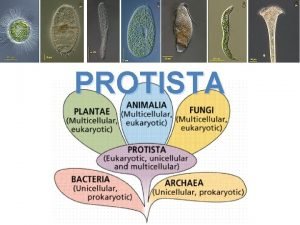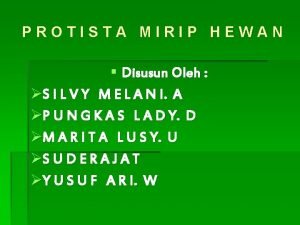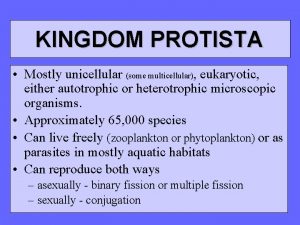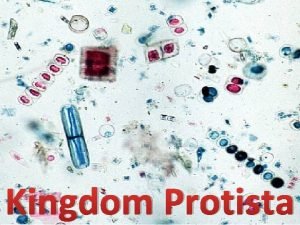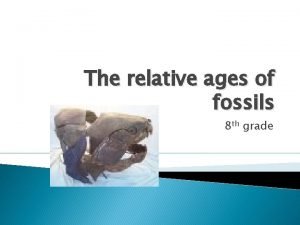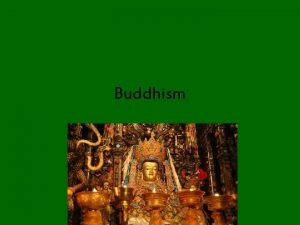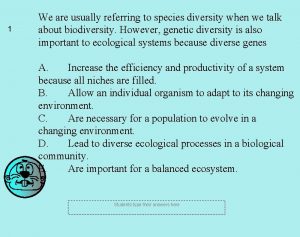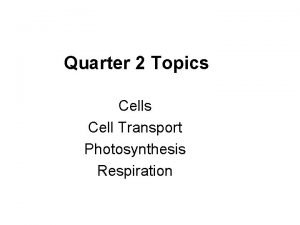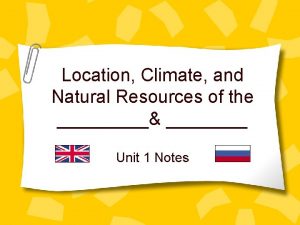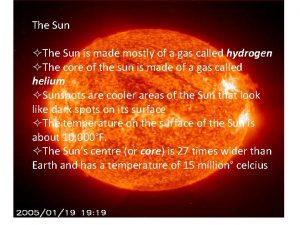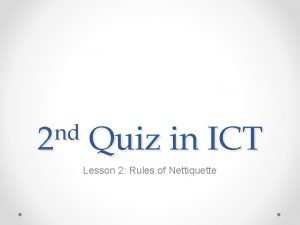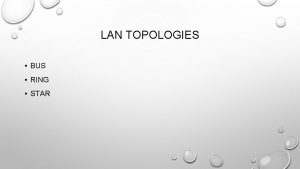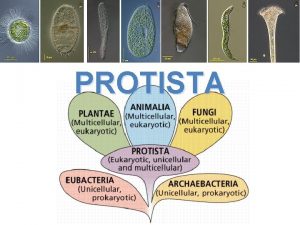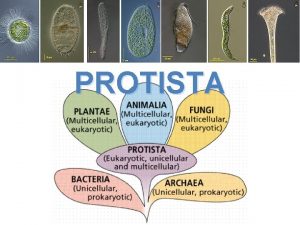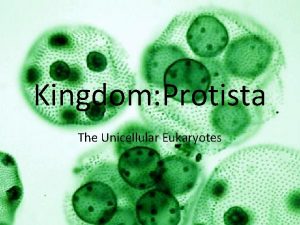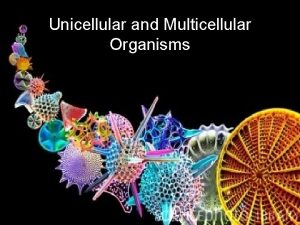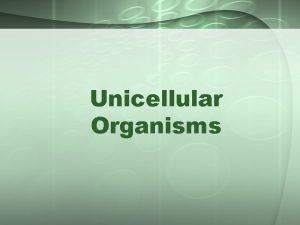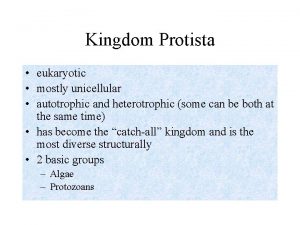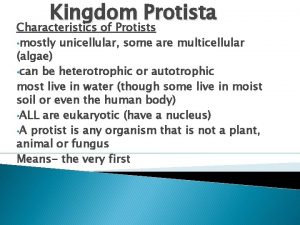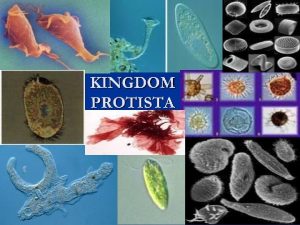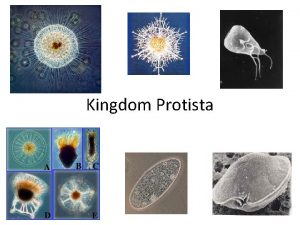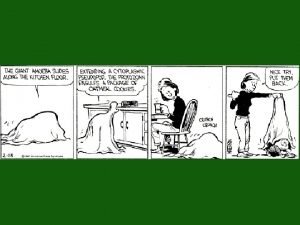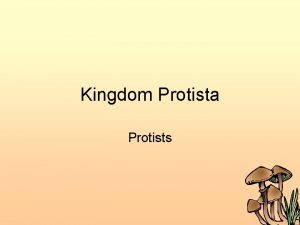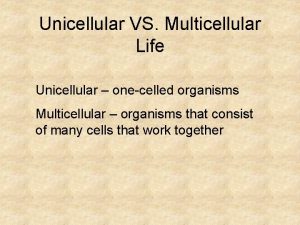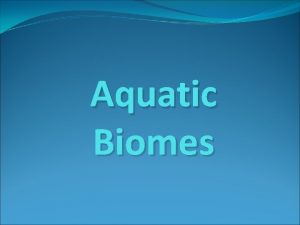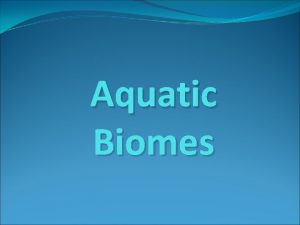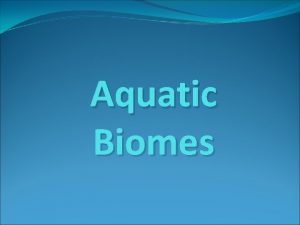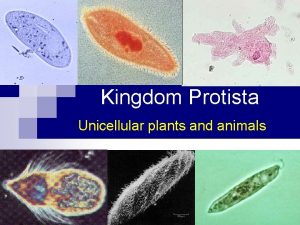PROTISTA In General Mostly aquatic life Usually unicellular





















- Slides: 21

PROTISTA

In General • Mostly aquatic life • Usually unicellular Animal-like – Eukaryotic • Reproduction: – Some asexual, some both Plant-like • Feeding: – Most heterotrophic, some autotrophic • Kingdom for life that doesn’t fit in animals, plant or fungi kingdom • 3 main categories Fungi-like Analogy: Kitchen junk drawer

Animal-Like Protista • AKA: Protozoans • Heterotrophic: pathogens, parasites, predators • Classified by how they move: 1) Pseudopods : move w/ pseudopodia (false- feet) – Engulf by phagocytosis – Ex: Amoebas

Animal-Like Protista • AKA: Protozoans • Heterotrophic: pathogens, parasites, predators • Classified by how they move: 1) Pseudopods : move w/ pseudopodia (false- feet) – Engulf by phagocytosis – Ex: Amoebas

Animal-Like Protista • AKA: Protozoans • Heterotrophic: pathogens, parasites, predators • Classified by how they move: 1) Pseudopods : move w/ pseudopodia (false- feet) – Engulf by phagocytosis – Ex: Amoebas 2) Flagellates: move w/ flagella – Ex: Trypanosoma causes sleeping sickness Giardia causes Vector: tsetse fly diarrhea Trypanosoma

Animal-Like Protista • AKA: Protozoans • Heterotrophic: pathogens, parasites, predators • Classified by how they move: 1) Pseudopods : move w/ pseudopodia (false- feet) – Engulf by phagocytosis – Ex: Amoebas 2) Flagellates: move w/ flagella – Ex: Trypanosoma causes sleeping sickness

Animal-Like Protista • AKA: Protozoans • Heterotrophic: pathogens, parasites, predators • Classified by how they move: 1) Pseudopods : move w/ pseudopodia (false- feet) – Engulf by phagocytosis – Ex: Amoebas 2) Flagellates: move w/ flagella – Ex: Trypanosoma causes sleeping sickness 3) Ciliates: move w/ cilia – Ex: Paramecia

Animal-Like Protista • AKA: Protozoans • Heterotrophic: pathogens, parasites, predators • Classified by how they move: 1) Pseudopods : move w/ pseudopodia (false- feet) – Engulf by phagocytosis – Ex: Amoebas 2) Flagellates: move w/ flagella – Ex: Trypanosoma causes sleeping sickness 3) Ciliates: move w/ cilia – Ex: Paramecia Rotifers beat their cilia to create a current to draw water into their “mouths”

Animal-Like Protista • AKA: Protozoans • Heterotrophic: pathogens, parasites, predators • Classified by how they move: 1) Pseudopods : move w/ pseudopodia (false- feet) – Engulf by phagocytosis – Ex: Amoebas 2) Flagellates: move w/ flagella – Ex: Trypanosoma causes sleeping sickness 3) Ciliates: move w/ cilia – Ex: Paramecia Amoeba (pseudopod) eating Paramecia (ciliates) The paramecia start to freak out once they start to be digested!

Animal-Like Protista & Disease • Disease: Malaria – Cause: Plasmodium – Vector: mosquitoes – Effects in humans: Fever, vomiting, coma, death Plasmodium injected by mosquito bite Plasmodium develop inside your liver Plasmodium reproduce inside your RBCs Plasmodium reenters mosquito when bitten

Plant-like Protista • AKA: Algae • Plant-like: Photosynthetic – No roots, no leaves, usually unicellular • Classified by their type of cell wall 1) Euglenoids: use flagella to swim – Plant-like: photosynthetic – Animal-like: swim

Plant-like Protista • AKA: Algae • Plant-like: Photosynthetic – No roots, no leaves, usually unicellular • Classified by their type of cell wall 1) Euglenoids: use flagella to swim – Plant-like: photosynthetic – Animal-like: swim

Plant-like Protista • AKA: Algae • Plant-like: Photosynthetic – No roots, no leaves, usually unicellular • Classified by their type of cell wall 1) Euglenoids – Plant-like: photosynthetic – Animal-like: swim 2) Dinoflagellates – Most plankton – Basis of aquatic food chains 3) Diatoms – Glasslike shells – Provide ~ ½ Earth’s O 2

Plant-like Protista • AKA: Algae • Plant-like: Photosynthetic – No roots, no leaves, usually unicellular • Classified by their type of cell wall 1) Euglenoids – Plant-like: photosynthetic – Animal-like: swim 2) Dinoflagellates – Most plankton – Basis of aquatic food chains 3) Diatoms – Glasslike shells – Provide ~ ½ Earth’s O 2

Fungus-like Protista • Decomposers: recycle nutrients • Mobile at stages of life cycle – Spores can develop cilia • Slime Molds: large (~1 meter) single celled mass of cytoplasm – Fungus & animal-like

Fungus-like Protista • Decomposers: recycle nutrients • Mobile at stages of life cycle – Spores can develop cilia • Slime Molds: large (~1 meter) single celled mass of cytoplasm – Fungus & animal-like

Fungus-like Protista • Decomposers: recycle nutrients • Mobile at stages of life cycle – Spores can develop cilia • Slime Molds: large (~1 meter) single celled mass of cytoplasm – Fungus & animal-like • Water molds: can be parasitic – Potato blight: disease (great potato famine in Ireland)

Fungus-like Protista • Decomposers: recycle nutrients • Mobile at stages of life cycle – Spores can develop cilia • Slime Molds: large (~1 meter) single celled mass of cytoplasm – Fungus & animal-like • Water molds: can be parasitic – Potato blight: disease

Protista: The Origins of Multicellular Life • Some protista are… • 1) Single-celled – Live by themselves • 2) Colonial – Group of independent acting cells – No specialized cells • 3) Multicellular – Cells specialized to be specific jobs • Importance: Ancestors of multicellular life This is a colony of cells Unicellular Euglena called Volvox Multicellular Kelp

Kingdom Protista Animal-like 1. Pseudopods • Move with false feet 2. Flagellates • Move with flagella 3. Ciliates • Move with cilia Plant-like 1. Diatoms • Glass-like shells 2. Dinoflagellates • Plankton 3. Euglenoids • Move like animals, autotrophs like plants Fungus-like 1. Slime molds • Move like animals, absorb food like fungi 2. Water molds • Often parasites • Responsible for Irish Potato Famine

Review • 1) Name three categories of protista. • 2) Which category of protista has members that are able to move? • 3) Which category of protista has members that absorb nutrients? • 4) Which category of protista has members that are heterotrophs? • 5) Which category of protista has members that hunt? • 6) How does a pseudopod, flagella, and cilia differ? • 7) Name the 3 major categories of protozoa. • 8) Name the 3 major categories of algae. • 9) Name the 2 major categories of fungus-like protista.
 Protist characteristics
Protist characteristics What kingdom is photosynthetic aquatic and unicellular
What kingdom is photosynthetic aquatic and unicellular Kingdom protista multicellular unicellular
Kingdom protista multicellular unicellular Protists unicellular or multicellular
Protists unicellular or multicellular Characteristics of kingdom protista
Characteristics of kingdom protista Strata are mostly found brainpop quizlet
Strata are mostly found brainpop quizlet What is this text mostly about?
What is this text mostly about? Horace morris but mostly dolores
Horace morris but mostly dolores Universalizing religion
Universalizing religion The main reason that there are relatively few invertebrates
The main reason that there are relatively few invertebrates The bubbles released by elodea contain mostly
The bubbles released by elodea contain mostly Where can we mostly asteroid found
Where can we mostly asteroid found Fabricated wounds are mostly
Fabricated wounds are mostly Russia's climate is mostly _____.
Russia's climate is mostly _____. Earth the third planet from the sun
Earth the third planet from the sun Hellmin
Hellmin A program designed to send you advertisement mostly pop-ups
A program designed to send you advertisement mostly pop-ups The solid portion of a comet phrase or clause
The solid portion of a comet phrase or clause The members of the counterculture movement were mostly
The members of the counterculture movement were mostly Five outer planets
Five outer planets Mostly fun
Mostly fun Bus, ring and star topologies mostly used in the
Bus, ring and star topologies mostly used in the

